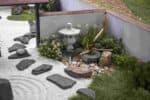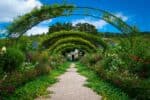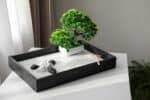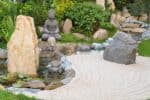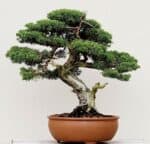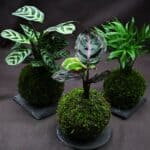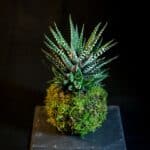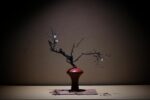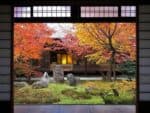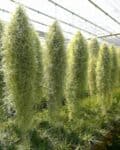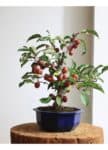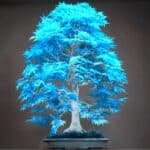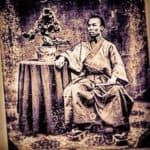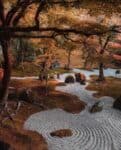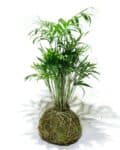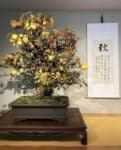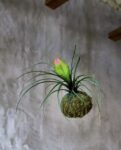Japanese gardens, also known as zen gardens, are meticulously designed as peaceful retreats. They make use of natural properties like water, plants, and rocks. I wondered how someone would go about building one of these gardens and I wanted to know about which gravel I should use.
So which gravel should you use for a Japanese garden? The best gravel for a Japanese gardens is Shirakawa-suna. This is made up of granite, quartz, black mica, and white feldspar. Another option is pea gravel which is tiny and smooth.
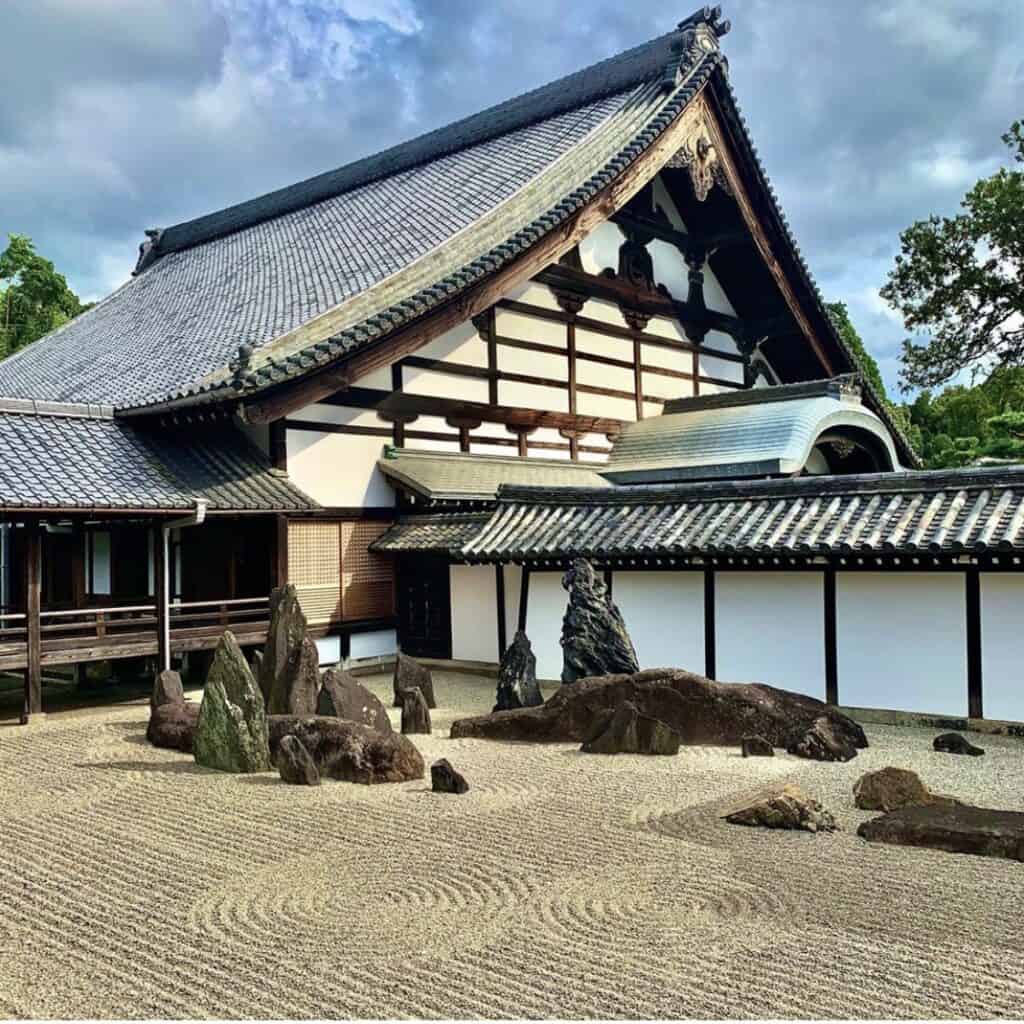

Zen gardens are the perfect way to add a little bit of peace and tranquility to your home. A place where you can destress, relax, and meditate. Find out more about different Japanese garden gravel options you can use in your Japanese garden art.
Check out my ultimate guide on: How to Decorate Your Japanese Garden.
Are There Other Types Of Gravel I Can Use?
When it comes to any Japanese gravel garden, they are meant to be a very personal creation. The gardener that designs the garden should allow their inner creativity to take the reins. While there are some common tropes and themes, you should feel encouraged to experiment with Japanese garden pebbles.
The most common type of zen garden gravel used is known as Shirakawa-suna, known for its rather muted color palette. This type of granite is a mix of white, black, and grey which matches the aesthetic of most zen gardens.
Another type of gravel that is commonly used is pea gravel. This kind of gravel is known to be tiny and smooth. It’s excellent to manipulate into the shape of waves on your garden floor.
The colors can vary for pea gravel but to remain authentic to traditional gardens, muted colors should be chosen. However, this is down to your discretion, if muted colors feel wrong, then by all means try something else.
Because of its small size, another common type of gravel used in the US is turkey grit. You are more likely to find this at a farm feed store, but it is perfect for your garden design. Turkey grit is used by the Museum of Fine Arts in Boston for its own zen garden.
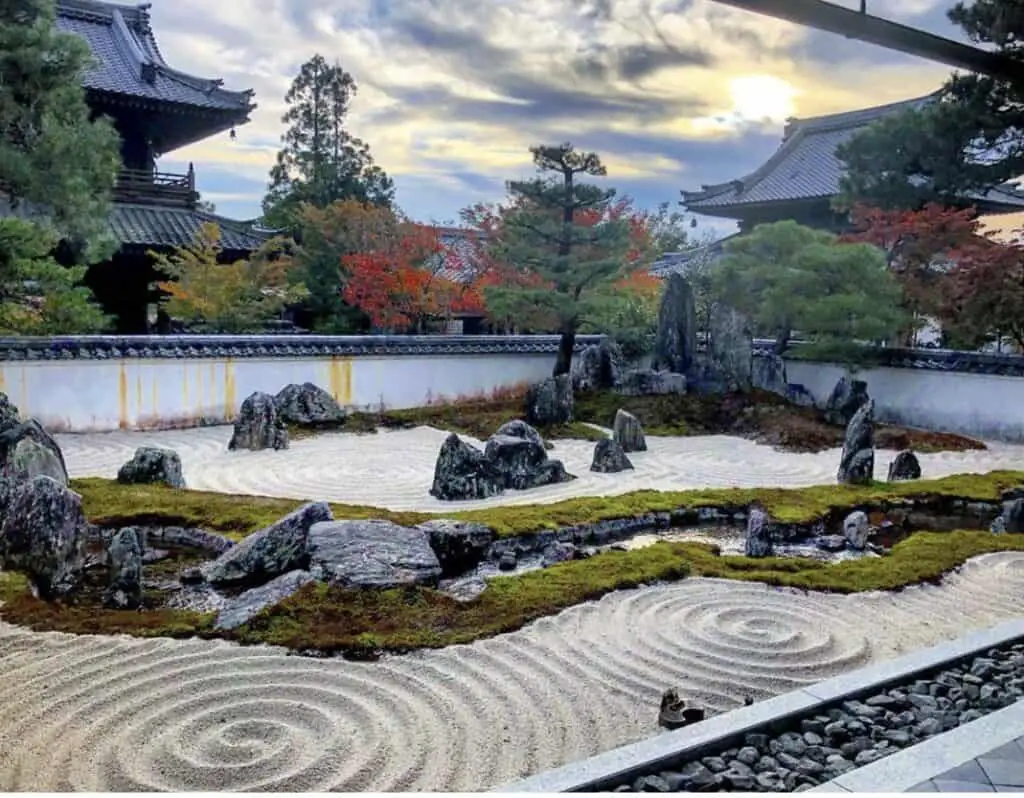
Designed perfectly for a place within a Japanese garden is Zen gravel. This is a beautiful kind of gravel to look at, it’s a silver and grey mix with salt and pepper flecks. The silver and grey design is perfect for imitating water when the garden is being viewed.
While it may be more widely known as something to feed chickens, a crushed oyster shell is an unusual but practical choice for your Japanese garden. This is a very cheap alternative but given that the shell is crushed so finely it becomes a superb alternative for gravel.
What you need to consider when deciding on gravel and rocks for a Japanese garden boils down to a few things. The colors used should be subdued. Instead of opting for bright and bold colors look for something darker, black, brown, or grey. White gravel is common as well, but white gravel reflects the stone, making it hard to look at.
Size is another important factor. Typically you want to look at small sizes, from 2mm to about 2cm. If you want to go larger you can, just try to make the garden floor consistent in size. You can mix up your gravel composition to suit your needs before laying and raking.
What is the Gravel Used For?
Gravel has a very important role to play in a Japanese garden. The rocks in these gardens are arranged as symbols of other objects like animals, water, mountains, trees, and other things to do with nature. The gravel is laid on the ground of the garden and then can be raked.
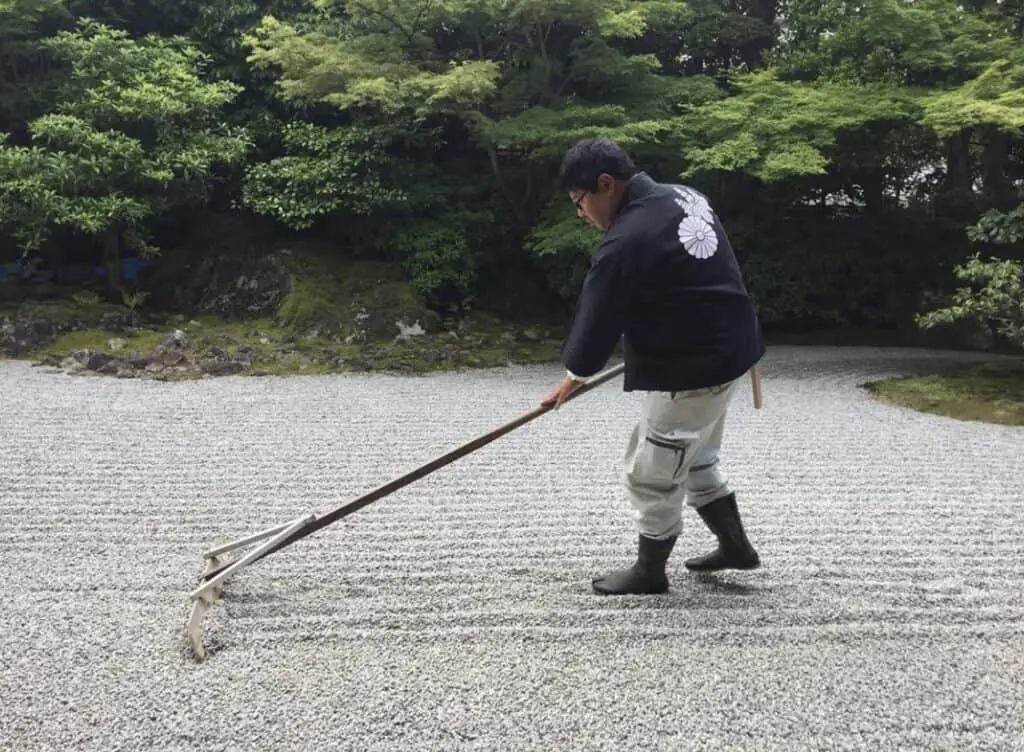
By raking the gravel you can create patterns in the ground. Gravel can be manipulated to symbolize waves and patterns of water. This is particularly the case for gardens that don’t have a water element to them
Raking is thought to be quite a relaxing exercise. Many people enjoy this aspect of building the garden. Raking of the gravel is a process known as samon.
Sometimes sand is used in zen gardens, although it is more common for gravel to be used. Gravel is much heavier than sand and so it is less likely to be disturbed by rain or wind. It is a challenge to perfect the lines while raking.
Zen priests will use the raking as a time to practice their concentration. Creating the patterns of the waves in the gravel is a creative challenge. It takes time and patience to perfect this.
A particular black-speckled granite from Kyoto called Shirakawa was well renowned for zen gardens. It held onto the raked grooves very well but it can no longer be sourced. The waterway where it can be found is now protected, so it is now illegal to harvest it.
Authentic Shirakawa can still be found in many temples inside of Japan, particularly in Kyoto. More recently, since the twentieth century, zen gardens have become more prominent in many countries beyond Japan. One such garden found in Portland, Oregon has some of the only Shirakawa found outside of Japan.
It was designed in 1963 and stretches out over 12 acres, featuring 8 different garden styles.
The former ambassador of Japan Nobuo Matsunaga even went as far as to proclaim it “the most beautiful and authentic Japanese garden in the world outside of Japan.” The garden is described as a place to discard your worldly thoughts and connect with the universe.
What Patterns Do You Make in the Gravel?
Symbolism is very important within these Japanese gardens. Understanding what patterns you can make should give you some inspiration. The gravel that is laid on the floor of the garden is manipulated by a rake to create eye-catching patterns.
When you’re picturing a zen garden in your head you probably imagine ripples in the gravel. This is a very popular pattern known as Mizumon. It’s intended to represent waves and is a very simple pattern.
The ripple pattern known as Sazanamimon is another commonly used one. This design represents the waves that occur around an island.
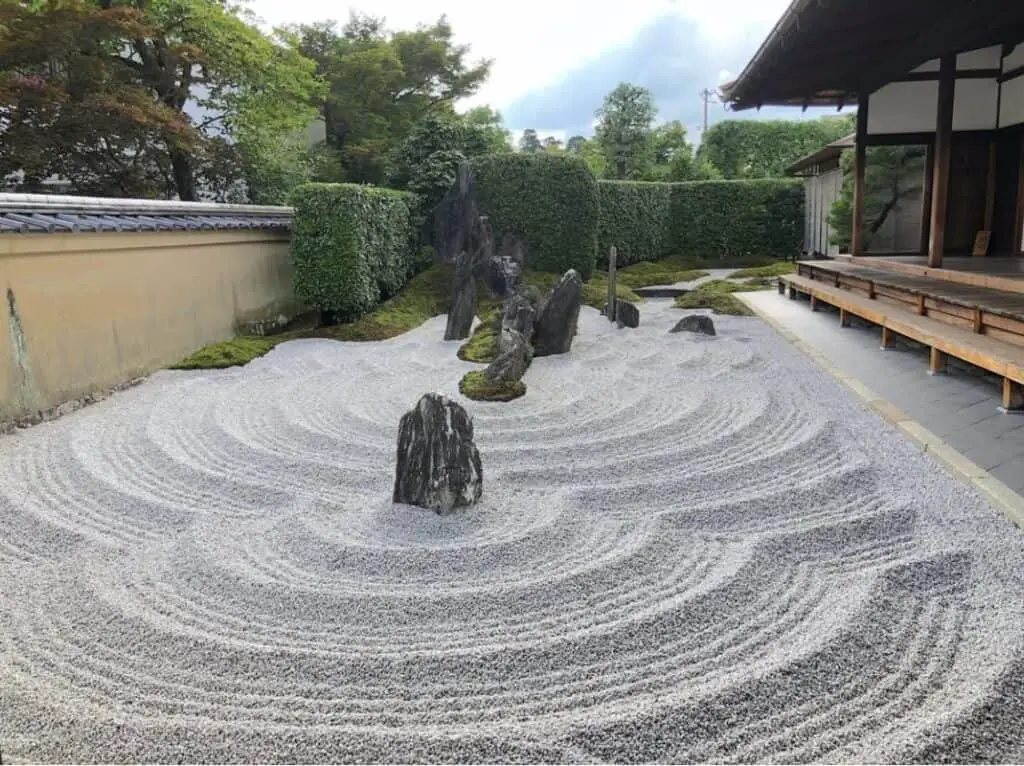
The Ryūsui pattern is for imitating running water. You use your rake to draw in the sand ripples that look like a flowing stream. This is a graceful pattern that should be designed with precision.
The Ginshanda pattern is similar to the Ryūsui in that they are both calm patterns. Ginshada is translated to mean “silver sand and open”. When raked into the gravel, draw a calm wave pattern.
Differing entirely is the Aranami pattern that can be translated to mean stormy waves. Just like its name would suggest, for this pattern you draw big and rough ridges that represent stormy seas.
The Tatsunami pattern is based on great waves in the sea. To recreate this pattern you would take your rake and draw a zigzag pattern in the gravel.
Another pattern that is based on the waves in the sea is the Seikaiha pattern. This pattern is similar to the common Mizumon pattern but you draw even greater waves in the floor.
My personal favorite pattern is known as Uzumaki-mon. This pattern represents vortices in the sea, it’s a complete loop of the rake to create a closed circular pattern. They’re incredibly eye-catching and can turn the calm zen garden into something more active.
This is one of the most creative outlets in Japanese garden design. Take your time to consider the pattern that best reflects you and what you are trying to achieve.
What Other Elements Are Used In Japanese Gardens?
While gravel lays the foundations of a Japanese zen garden, many other elements are used as well. The gravel is designed to represent water, but larger stones are used as well. Instead of representing water, they represent the mountains and hills, islands, and waterfalls.
Rocks
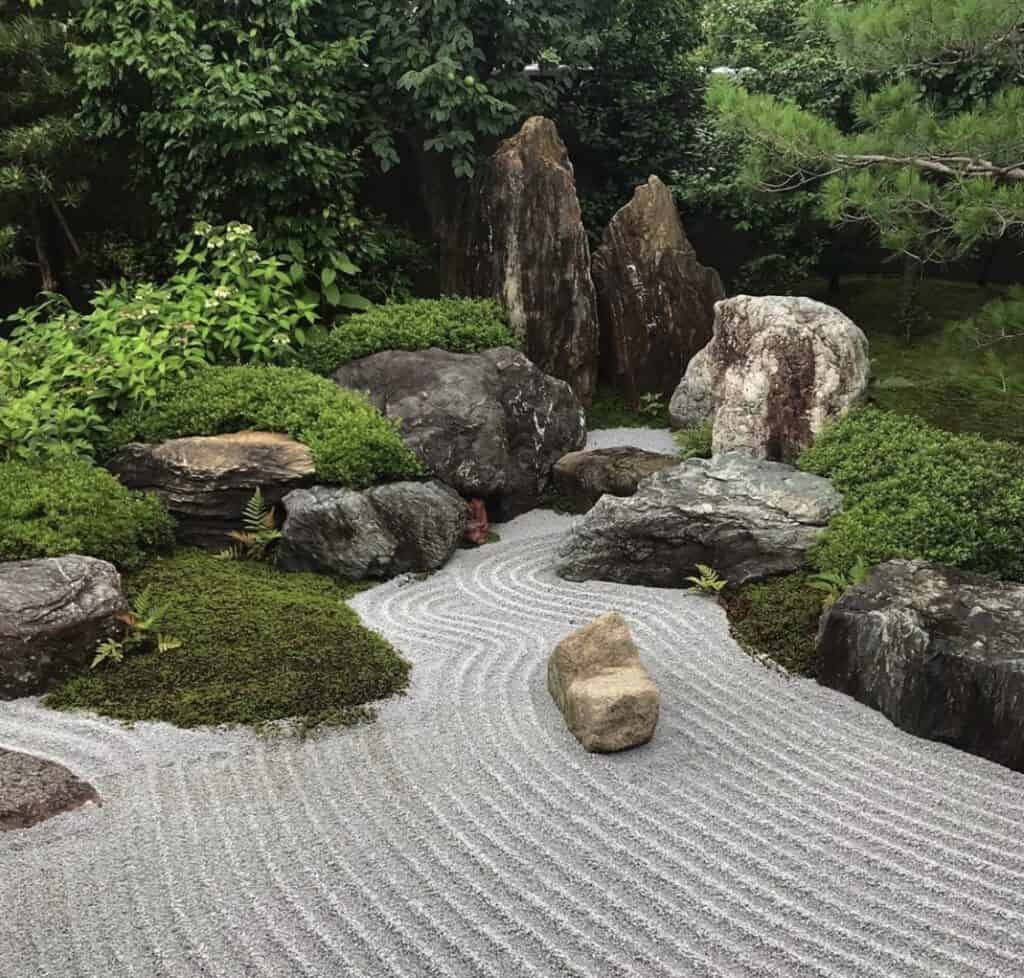
In gardens that feature a water element, stones and rocks can be used to line along ponds or streams. In walking gardens stones will be laid down to make a path.
Rocks will be laid out adhering to quite strict rules. They are matched depending on their shape and size and are usually paired by style contrast. The rocks will be placed on top of the gravel and should be done before you rake.
The placement of rocks is considered the most important part of making a Japanese garden. The first known manual of Japanese gardening called the Sakuteiki (which translates to Records of Garden Making) goes as far as to warn gardeners. If the rules for setting out the rocks were not followed then the garden would suffer misfortune.
To symbolize mountains, the rocks used would typically be rugged rocks that have sharp edges. Usually stones from actual mountains. For rocks used to represent a river or the sea, smooth round rocks are used.
A common formation used is that of a tall rock between two smaller rocks, meant to represent Buddha and his attendants. Other rocks may be placed in random locations to add some spontaneity.
Water
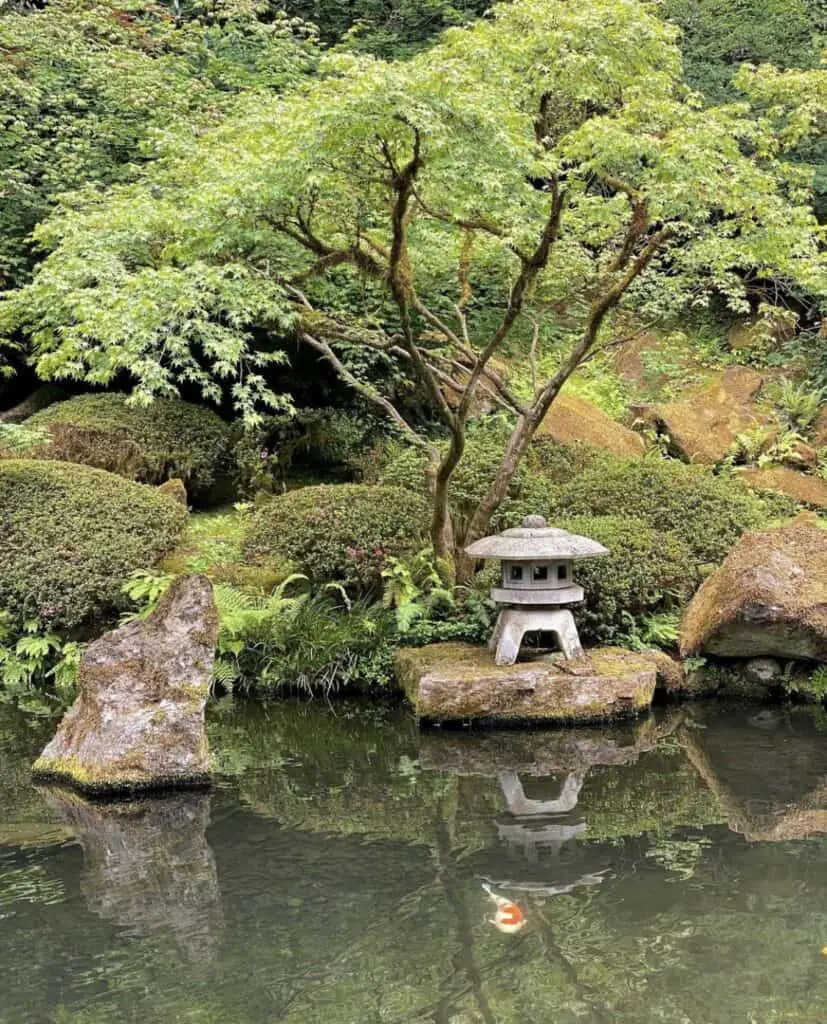
Not all zen gardens utilize water, for example, dry gardens would be devoid of any water. In this case, sand or gravel is used and designed to represent water.
However, plenty of Japanese gardens will have water features as a part of them. From ponds to streams, there are a variety of different options.
Usually, water will be a central part of the garden and occasionally the home to koi fish. Water that flows in cascades can add to the atmosphere of the garden, perfect for meditation. Water is an expression of nature meant to promote calm and relaxation.
In dry landscape gardens gravel is used to represent water. Gravel can also be utilized in other types of gardens where water does feature. But it takes a prominent role in dry landscape versions.
Bridges
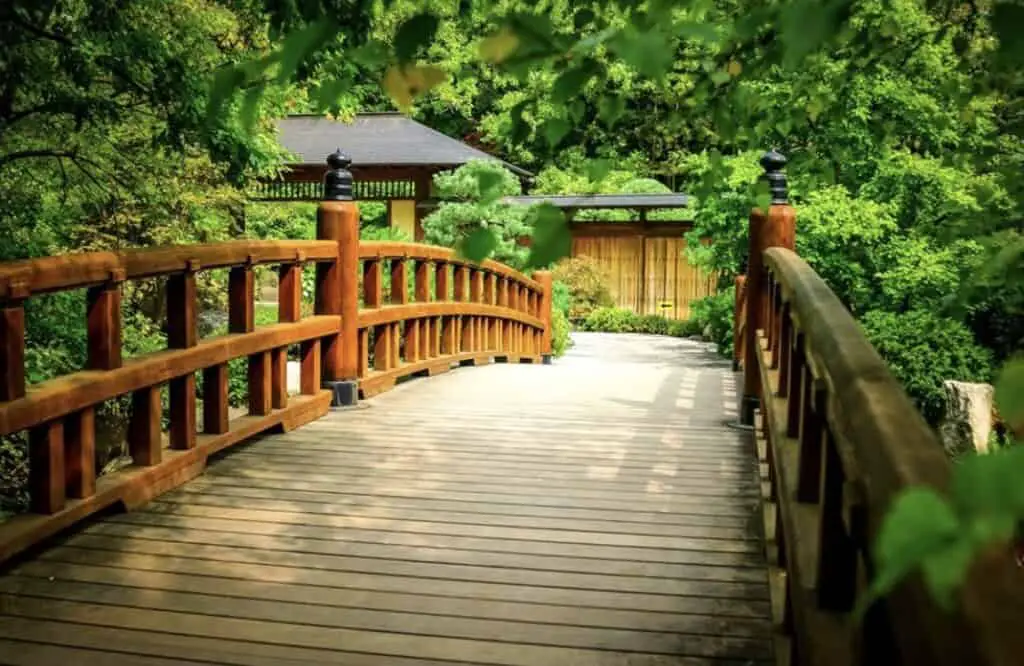
Bridges are something that may not be found in all gardens, particularly small gardens or dry gardens. The bridges are important parts of the garden and are placed so that the guest better appreciate it.
When crossing over a bridge, take your time and really savor the moment. Look across the entire landscape, watch the carp go about their day, and allow your senses to take it all in.
Bridges are usually made out of wood or stone. They can be used to connect to different islands within the garden. The bridges vary in scale, some are simply a singular rock placed in a stream, or can be over 10 meters long.
Bridges can be laid out into the gravel, by using stepping stones you are able to craft a path for someone to follow. The benefit of doing this is that your patterns will remain undisturbed while people traverse through the garden.
Vegetation
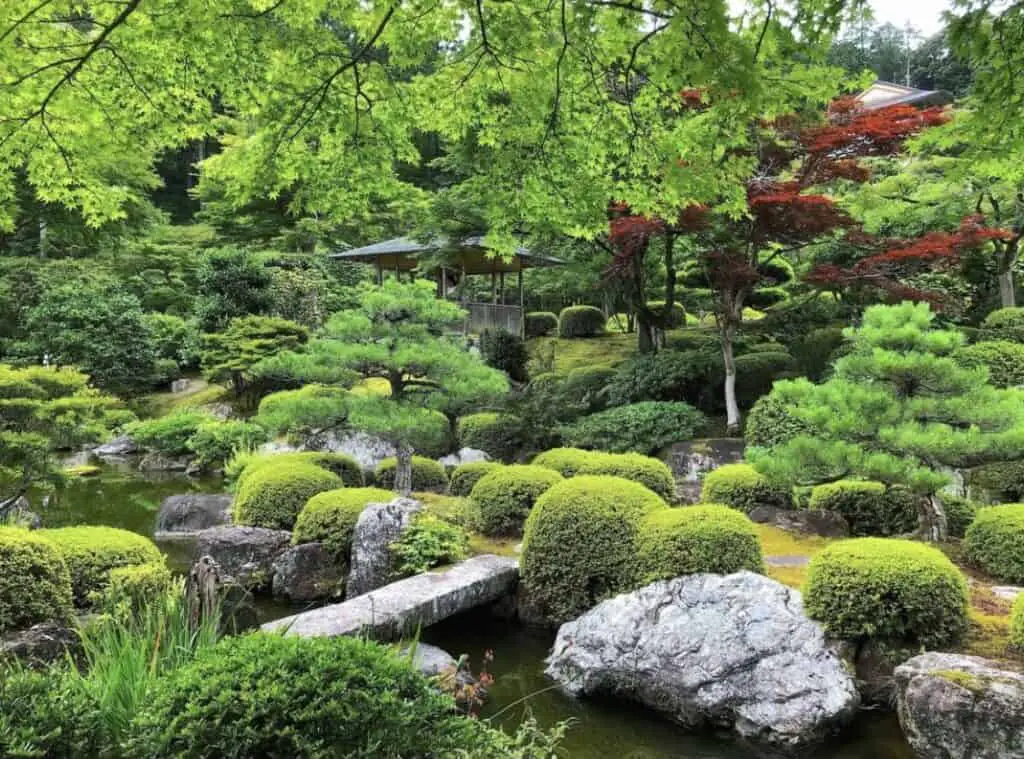
All sorts of different vegetation are used in a Japanese garden. This includes grass, shrubbery, trees, and flowers, and they can change with the season. For example, in winter pine trees and bamboo are grown while other plants can’t due to the harsher climate.
The plants are carefully placed in the garden, trying to imitate nature. Gardeners will go to great lengths to maintain the plants in the garden.
Moss is also encouraged to grow and is well looked after too. Moss is kept clean and any debris that has got caught is removed. Moss can grow anywhere within the garden.
Consider these Japanese zen gardens as jumbo-sized bonsai trees. The same level of care is shown to the plants that grow here. They are shaped by the gardener to their symbolic or artistic whim.
Lantern
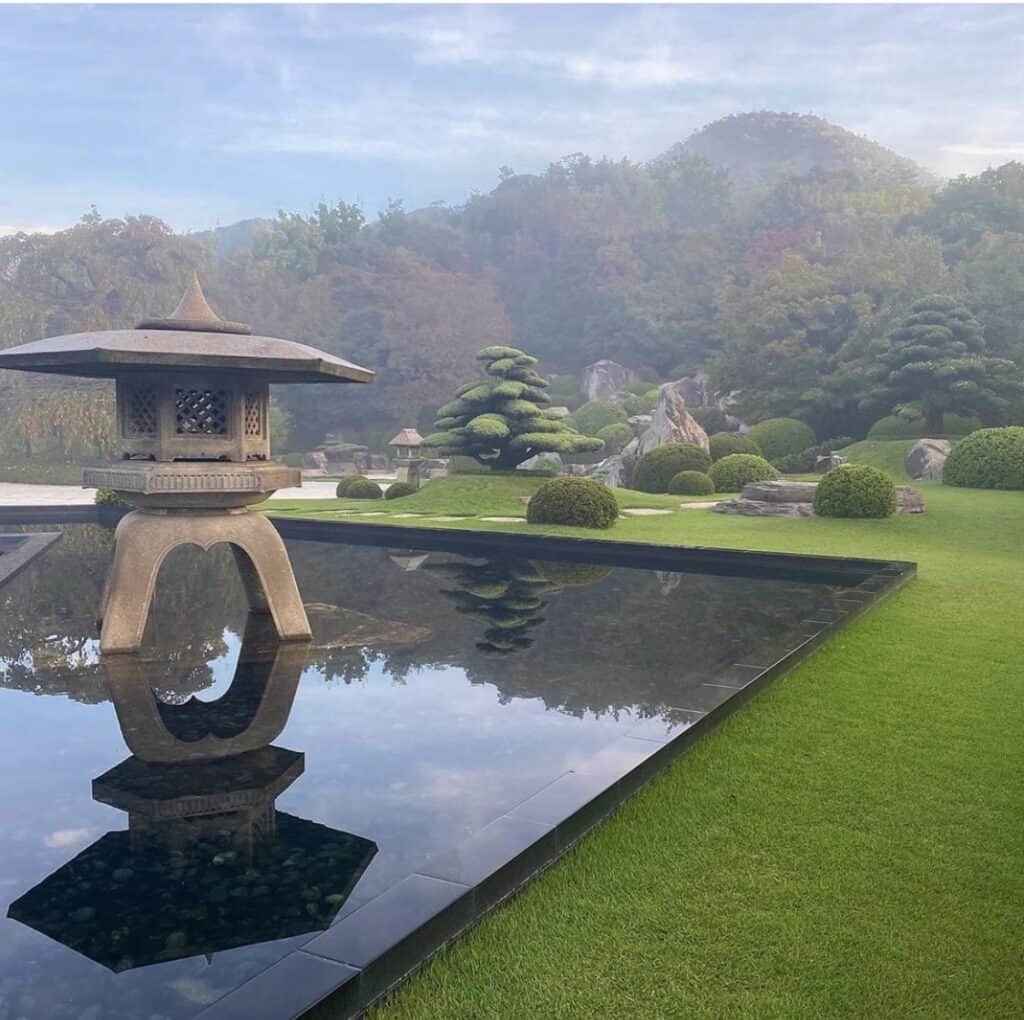
Lanterns have been a very common part of Japanese gardens. The lanterns can come in different shapes and sizes to fit the garden they are in. They have become a prime element in garden design.
The original function of the lantern was to illuminate the way and guide guests at night. They can usually be found on islands, near paths, and next to buildings, and can provide a wonderful aesthetic to the garden.
The gardens are intended to represent nature and naturally occurring things like mountains or rivers. The lantern on the other hand provides a contrast to that as it’s man-made and designed.
How Do You Build Your Own Japanese Garden?
This is an incredibly involved and creative process. Take your time and really savor the moments you spend creating your garden. There is no set design for Japanese gardens, each one is going to differ from the last.
Firstly, you will need to decide on what kind of gravel you will use. It can be finely crushed gravel, or in some cases, it can be sand. Once you have laid your gravel you need to place the larger rocks.
These rocks are meant to represent the mountains and they can be placed anywhere on the gravel. The rocks can vary in size from small to tall, and short to long. Listen to the rocks and they can help inform your garden.
You will also need to rake the gravel to create patterns associated with nature. The gravel is meant to represent water so you should try and create waves. This process is very creative and forms part of the garden’s meditation.
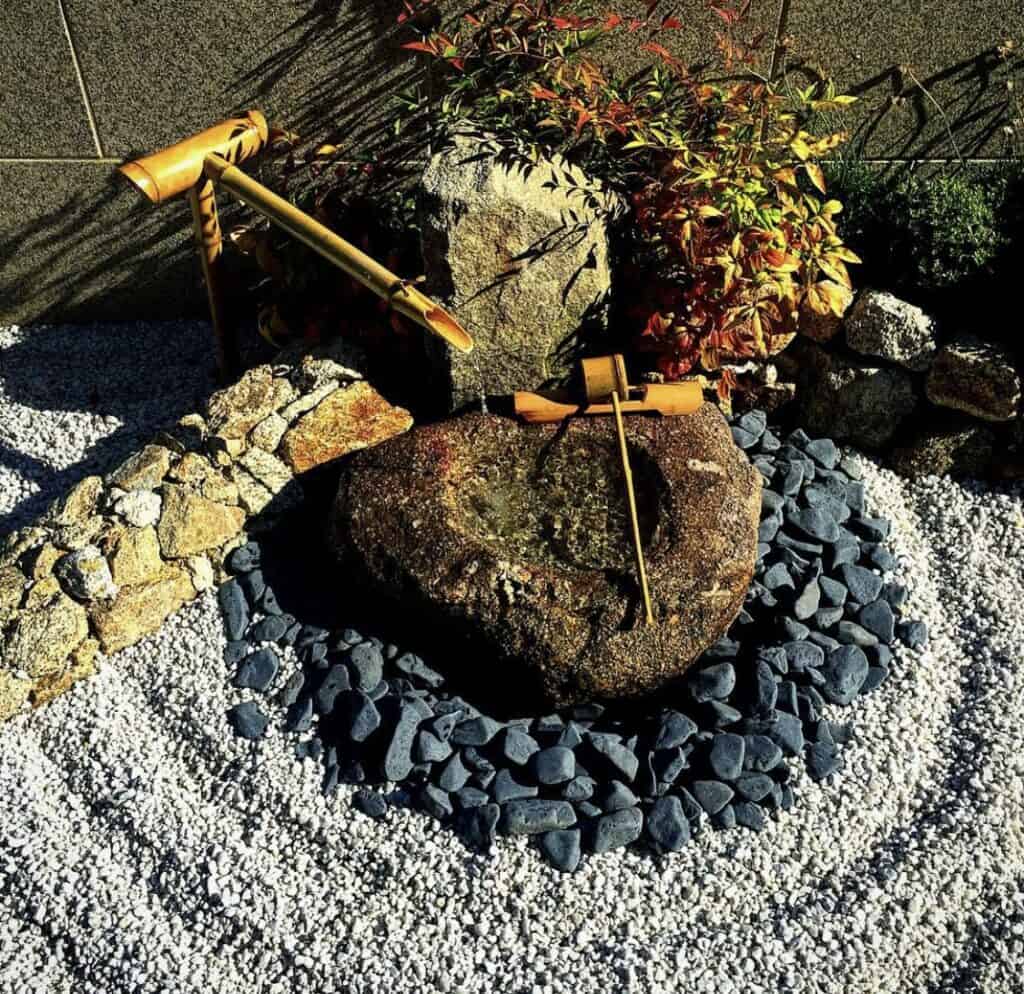
It is not easy to perfect the raking of the gravel, but it is not something that should be rushed. Rather, patience is the key here, remember this is an experience that should help you reach enlightenment.
Japanese gardens aren’t about the size and they can usually fit into whatever space you have available. The design of these gardens is intended to be very minimalistic and simple. Colourwise, they are supposed to be quite muted, with the greys of the gravel and rocks mixed with green moss and plants.
More colorful gardens are actually derivative of Chinese designs. Chinese gardens are more likely to include bolder colors such as red.
Many of these gardens are walled off, and the perfect thing to use as a fence is bamboo. This keeps with the nature aspect of these gardens and adds to the design.
You can create stone pathways that flow through the garden. Particularly past things like buildings, statues, and lanterns. The paths are there to represent anticipation for the future while respecting your past.
You can add plants and other vegetation to your garden, but try not to go overboard. The plants will need to be maintained so adding too many large plants may bring added pressure. This would be counterintuitive to the garden which is meant to bring peace.
Simplicity really is the key here, so less is more. The garden needs to be a place that you will want to visit and spend time maintaining. While you work in the garden your mind can allow itself to relax and become zen.
Zen gardens can come as small in size, as to fit on your desk. While the grander, more expanse gardens are surely a sight to behold. These small gardens are designed to aid with self-reflection in much the same way. Encouraging you to use the garden as a viewpoint but also as the gardener yourself.
For inspiration take a look at pictures of zen gardens, both in people’s homes and in temples all over Japan. Big or small, Japanese gardens are wonderful to behold. However, your garden should be unique to yourself, trusting in your own instincts.
Materials and Tools Required for Creating a Japanese Rock Garden
Now you know all the basics of lovely Zen gardens, but before you start creating one by yourself, you’ll need to stock up on some necessary materials and tools. Here’s what you’ll need:
- Gravel of a lighter color, such as grey or white,
- Japanese garden stones that will be used as feature stones,
- An ordinary rake or a Japanese one, whatever is available to you,
- Several drilled monoliths for water features or undrilled ones for natural focal points,
- Different slate chippings you’ll use to create a border detail,
- A membrane for weed prevention,
- Assorted plants meant to be used in a Zen garden,
- Compost and topsoil for planting trees and other plants,
- A string or a marker spray to mark the area,
- A spade you’ll use for moving soil,
- A trowel.
Enjoy Your Hard Work
Now that you have these guidelines to help you, nothing is stopping you from arranging your own rocks for the Japanese garden, gravel, plants, and everything else that will create your own piece of zen. While the water and some of the other features are optional, the more things you add (with caution not to over-clutter) the lovelier it will be. Now, grab a rake and some gravel and soil, and create a space for meditation and enjoyment.
